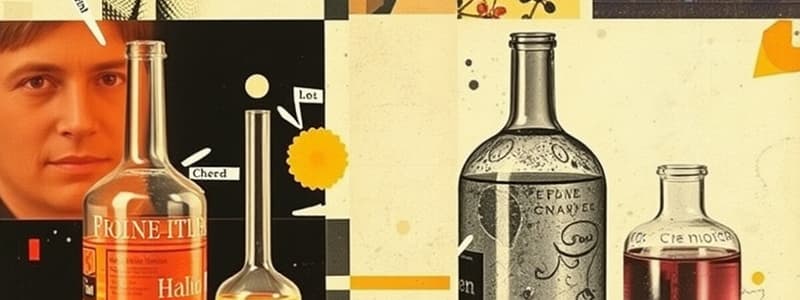Podcast
Questions and Answers
A solution is always a homogenous mixture where one or more substances dissolve into a solvent.
A solution is always a homogenous mixture where one or more substances dissolve into a solvent.
True (A)
Heterogenous mixtures always separate into distinct layers, like sand in water.
Heterogenous mixtures always separate into distinct layers, like sand in water.
False (B)
Mixtures have a fixed composition, meaning their components are always present in the same ratio.
Mixtures have a fixed composition, meaning their components are always present in the same ratio.
False (B)
Homogenous mixtures have an even distribution of their components, making them appear uniform throughout. Heterogeneous mixtures, conversely, have particles spread unevenly.
Homogenous mixtures have an even distribution of their components, making them appear uniform throughout. Heterogeneous mixtures, conversely, have particles spread unevenly.
Pure substances, such as table salt (sodium chloride), are typically found in a perfectly pure (100%) state naturally.
Pure substances, such as table salt (sodium chloride), are typically found in a perfectly pure (100%) state naturally.
Refining is a chemical process used to isolate pure substances from natural sources.
Refining is a chemical process used to isolate pure substances from natural sources.
Table salt, water, baking soda, gold, and diamonds are examples of impure mixtures.
Table salt, water, baking soda, gold, and diamonds are examples of impure mixtures.
Gold is a compound found within the Earth's surface.
Gold is a compound found within the Earth's surface.
Pure substances in nature are always completely free of any other substances.
Pure substances in nature are always completely free of any other substances.
Both physical and chemical properties can assist in the identification of a pure substance.
Both physical and chemical properties can assist in the identification of a pure substance.
A pure substance's electrical conductivity remains unaffected by its purity levels.
A pure substance's electrical conductivity remains unaffected by its purity levels.
Pure substances produce consistent and expected outcomes in chemical reactions.
Pure substances produce consistent and expected outcomes in chemical reactions.
The atomic mass of an element is determined by the weighted average of its isotopes.
The atomic mass of an element is determined by the weighted average of its isotopes.
Isotopes are atoms of different elements containing the same number of neutrons.
Isotopes are atoms of different elements containing the same number of neutrons.
Dmitri Mendeleev organized the periodic table based on the number of protons in each element.
Dmitri Mendeleev organized the periodic table based on the number of protons in each element.
Flashcards
Solution
Solution
A homogeneous mixture of solutes dissolved in a solvent.
Homogeneous Mixture
Homogeneous Mixture
A mixture with an even composition throughout.
Heterogeneous Mixture
Heterogeneous Mixture
A mixture with a non-uniform composition.
Colloid
Colloid
Signup and view all the flashcards
Compound vs. Mixture
Compound vs. Mixture
Signup and view all the flashcards
Refining
Refining
Signup and view all the flashcards
Pure Substance
Pure Substance
Signup and view all the flashcards
Mixture
Mixture
Signup and view all the flashcards
Element
Element
Signup and view all the flashcards
Atomic Number
Atomic Number
Signup and view all the flashcards
Mass Number
Mass Number
Signup and view all the flashcards
Isotopes
Isotopes
Signup and view all the flashcards
Periodic Table
Periodic Table
Signup and view all the flashcards
Chromatography
Chromatography
Signup and view all the flashcards
Distillation
Distillation
Signup and view all the flashcards
Study Notes
Solutions
- Solutions are homogenous mixtures of one or more solutes dissolved in a solvent.
- Examples include sodas, seawater, air, and metal alloys.
- Homogenous mixtures cannot visibly differentiate their components.
- When an ionic compound dissolves, it dissociates into cations and anions.
- Solutions can be classified based on the state of solute and solvent: solid-solid (bronze), liquid-liquid (hand sanitizer), gas-gas (air), solid-liquid (sports drinks), liquid-gas (sodas), and gas-solid (hydrogen gas and platinum).
- Non-homogenous mixtures are called heterogeneous mixtures.
- Suspensions are heterogeneous mixtures that separate into layers (sand in water).
- Colloids are heterogeneous mixtures that do not separate (milk).
Mixtures
- Mixtures are substances where constituent substances are not in a fixed proportion.
- Mixtures are impure substances with variable compositions.
- Composition changes based on the source.
- Mixtures display the properties of their components.
- Examples include blood, milk, salt and water, and sand and water.
- Homogenous mixtures have an even distribution of particles (salt and water).
- Heterogeneous mixtures have an uneven distribution of particles (sand and water).
- Mixtures differ from compounds, which are pure substances with fixed compositions.
- Compounds are formed through chemical bonding, while mixtures are formed through physical mixing.
Pure Substances
- Pure substances are made up of one type of element or compound.
- Examples include table salt, water, baking soda, gold, and diamonds.
- Purity is a measure of how pure a substance is.
- Pure substances ideally have 100% purity, but are usually not.
- Refining is used to extract pure substances from nature.
- Distillation is one method to refine substances like water to improve purity.
- Pure substances have specific physical and chemical properties.
- These properties can be used for identification.
- Melting and boiling points are at specific temperatures.
- Conductivity can be affected by purity.
- Pure substances have predictable reactivities in chemical reactions.
Separation of Mixtures
- Mixtures are formed when two or more components are physically combined.
- Solutions and alloys are homogeneous mixtures.
- Examples include air, steel, saltwater, and gasoline.
- Suspensions and colloids are heterogeneous mixtures.
- Examples include pizza, a bag of marbles, and sandy water.
- Different physical methods can separate mixture components, including:
- Chromatography (separation based on different affinities for a mobile and stationary phase. Retention factor is calculated by dividing the distance travelled by the component by the distance travelled by the solvent)
- Distillation (based on different boiling points)
- Evaporation and crystallization (based on vaporization of solvent)
- Filtration (separates solids from liquids in heterogeneous mixtures)
- Dissolving, evaporation, or filtration (to separate multiple components)
- Magnetism (separates magnetic metals)
- Manual separation (for larger components)
Atoms and Subatomic Particles
- Atoms consist of protons, neutrons, and electrons.
- Protons have a positive charge and a weight of 1 amu. They are found in the nucleus.
- Neutrons have no charge and a weight of 1 amu. They are found in the nucleus.
- Electrons have a negative charge and no weight. They are found outside the nucleus.
- Atomic number (Z) represents the number of protons in an atom. All atoms of the same element have the same atomic number. It can be found on the periodic table.
- Mass number (A) represents the number of protons and neutrons in an atom. It is measured in amu and is not found on the periodic table; it depends on the isotope.
- Isotopes are atoms of the same element with different numbers of neutrons.
- Atomic mass is the weighted average of the mass numbers of the isotopes of an element, found on the periodic table.
The Periodic Table
- The periodic table organizes elements based on their number of protons (atomic number).
- Early attempts included Dobereiner's Law of Triads and Newlands' Law of Octaves.
- Dmitri Mendeleev is considered the "Father of the Periodic Table".
- Henry Moseley arranged the modern periodic table based on atomic number.
- The periodic table has horizontal rows called periods and vertical columns called groups.
- Elements are classified as metals, nonmetals, or metalloids.
- Periodic trends help predict element properties (valence electrons, atomic radius, ionization energy, electronegativity, electron affinity, oxidizing nature, metallic character).
Metals
- Metals are shiny, hard, conductive, ductile, and malleable materials.
- Five types of metals are: alkali, alkaline earth, transition, lanthanides, and actinides.
- Alkali and alkaline earth metals are in the s-block.
- Transition metals are in the d-block.
- Lanthanides and actinides are in the f-block.
- Examples of metals include iron, gold, silver, and zinc.
- Low ionization energy leads to high reactivity in metals.
- All metal types form hydroxides, halides, and oxides.
- Transition, lanthanide, and actinide metals form complexes with ligands.
Metalloids
- Metalloids have properties of both metals and nonmetals.
- Examples include boron, silicon, germanium, arsenic, antimony, tellurium (sometimes bismuth, polonium, and astatine).
- Metalloids are located on a line between Groups 13 and 16/17/18, separating metals from nonmetals.
- Physical properties include: solid at standard conditions, metallic luster, brittle, semiconductors.
- Chemical reactivity varies among metalloids.
Nonmetals
- Nonmetals generally have high ionization energies, electronegativities, low boiling points, and are poor conductors of heat and electricity.
- Reactions between metals and nonmetals usually form ionic compounds.
- Nonmetals typically form covalent bonds when reacting with each other.
- Most nonmetals occur as gases at room temperature; others are solids, with one being a liquid.
- Nonmetals are found primarily on the right side of the periodic table, but hydrogen is in the upper left .
- Found in families like halogens, noble gases, and some metalloids. They occupy groups 13-18 except hydrogen which is in group 1.
Studying That Suits You
Use AI to generate personalized quizzes and flashcards to suit your learning preferences.




